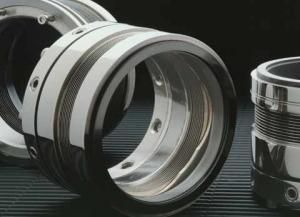Why an ‘equivalent orifice’ must exist in gas seals

Close attention to a mechanical seal used in pump applications and a dry gas mechanical seal utilized for compressor applications will show reliefs of the rotating face of the seal.
Considering that both seals operate on a fluid may give some hint as to why the designs are so very similar. The objective of seal design is to positively minimize leakage while removing frictional heat, in order to obtain reliable, continuous operation of the seal. In a liquid application, the heat is removed by the fluid which passes between the stationary faces and the seal flush and changes from a liquid to gaseous state (heat of vaporization).
This is precisely why all seals are said to leak and explains the recent movement of the industry to seal-less pumps in toxic or flammable service. If the fluid between the rotating faces now becomes a gas, its capacity to absorb frictional heat is significantly less than that of a liquid. Therefore, an ‘equivalent orifice’ must continuously exist between the faces to reduce friction and allow a sufficient amount of fluid to pass and this take away the heat.
The problem obviously is how to obtain this ‘equivalent orifice’. There are many different designs of gas seals. However, regardless of the design, the dynamic action of the rotating face must create a dynamic opening face that will overcome the static closing forces acting on the seal to create an opening and hence ‘equivalent orifice’.
When rotating, the vanes create a high head, low flow, impeller that pumps gas into the area between the stationary and the rotating face, thereby increasing the pressure between the faces. When the pressure is greater than the static pressure holding the faces together, the faces will separate, thus forming an equivalent orifice. In this specific seal design, the annulus below the vanes forms a tight face such that under static (stationary) conditions, zero leakage can be obtained if the seal is properly pressure-balanced.
Ranges of operation
Essentially, gas seals can be designed to operate at speeds and pressure differentials equal to or greater than those of liquid seals. Present state-of-the-art (2010) limits seal face differentials to approximately 17,250 kPa (2,500 psi) and rubbing speeds to approximately 122 meters/second (400 feet/second). Temperatures of operation can reach 538oC (1,000oF). Where the seal face differential exceeds these values, seals can be used in series (tandem) to meet specifications, provided sufficient axial space is available in the seal housing.
Leakage rates
Since the gas seal when operating forms an equivalent orifice, whose differential is equal to the supply pressure minus the seal reference pressure, there will always be a certain amount of leakage.
It can be stated in general that, for most compressor applications with suction pressures of the order of 3,450 kPa (500 psi) and below, leakage can be maintained at around one standard cubic foot per minute per seal. For a high pressure application (17,250 kPa or 2,500 psi), differential leakage values can be as high as 8.5 Nm3/hr (5scfm) per seal.
As in any design, the total leakage is equal to the leakage across secondary seals (‘O’ rings, etc.). There have been reported incidences of explosive ‘O’ ring failure on rapid decompression of systems incorporating gas seals, thus resulting in excessive leakage. Consideration must be given to the system under consideration, to tailor system decompression times to meet the requirements of the secondary seals.
As previously mentioned, all gas seals will leak, but not until the face ‘lifts off’. This speed known, oddly enough, as ‘lift off speed’ is usually less than 500 rpm. Caution must be exercised in variable speed applications to ensure that the system prevents the operation of the variable speed driver below the lift-off value.
One recommendation concerning instrumentation is to provide one or two thermocouples in the stationary face of each seal to measure seal face temperature. This information is very valuable in determining lift-off speed and condition of the grooves in the rotating seal face. Any clogging of these grooves will result in higher face temperature and will be a good indication of requirement for seal maintenance.